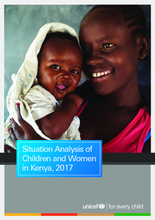Introduction
1. In September 2016, Kenya’s Government launched its national implementation plan for the Sustainable Development Goals, and expressed commitment that ‘no one will be left behind’ in the economic and social prosperity of the country. This report, produced by UNICEF as part of its country programme, is intended to support the Government to meet this commitment.
2. The report presents an overview of the Situation of Children and Women in Kenya using the results of the most significant research and analysis between 2014 and 2017 in areas related to the wellbeing of children and women. It is the product of a desk review of key reports, studies, surveys and evaluations produced in the last three years in the area of child rights and associated issues in Kenya by the Government and its development partners, as well as a series of interviews with national and local officials and other stakeholders. By focusing on the key knowledge gaps related to inequities and child deprivations and promoting the broad engagement of all stakeholders, the Situation Analysis is intended to contribute to implementation of Kenya Vision 2030, to support achievement of national and child-related sustainable development goals.
3. The Situation Analysis is divided into several sections. The background section provides information on the geographical, political, economic and social situation in Kenya; and the Enabling Environment section looks at more specific aspects of governance for children in the country. This is followed by six sections that focus on key issues affecting the lives of children and women in the country today:
- Surviving, which focuses on health and nutrition challenges
- Learning, primarily looking at access to and quality of education
- Protection from violence, abuse, exploitation and family separation
- Safe and clean environment, looking at water, sanitation, housing and energy
- Children and emergencies, covering the effects of natural disasters, security challenges, and refugee children; and
- Equitable chances in life, highlighting the situation of children with disabilities, challenges ensuring birth registration, the social protection system and adolescent empowerment.

